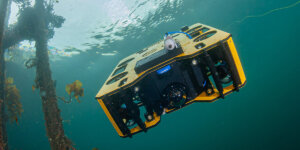
PHOTO/PEXELS, CHRIS LEBOUTILLIER.
As a kid, Philip Fine, former USC Viterbi School of Engineering research assistant professor, liked taking apart things. When things didn’t work, he built elaborate pulley systems to achieve tasks like turning on a light switch from 30 feet away with a piece of string.
“I was told if you’re good at math and science, you should be an engineer,” he said. “I didn’t know what that was, but at 16, it sounded as good as anything.”
For a career he seemingly fell into, Fine has certainly made a mark. After two decades of impacting air quality regulations and monitoring, he has been appointed to the leadership team of the U.S. Environmental Protection Agency.
Originally from Northern California, Fine has parlayed his concern and prowess at monitoring air quality and interpreting hard science for diverse stakeholders into helping influence rules and regulations at top levels. It wasn’t always obvious he’d end up here; as an undergraduate, there weren’t environmental engineering or science programs available at most universities. Fine studied mechanical engineering at UC Berkeley instead. It wasn’t until his graduate studies at Caltech that he leaned deeper into exploring environmental issues.
After completing his PhD at Caltech, Fine worked as a research assistant professor in the USC Viterbi School’s Sonny Astani Department of Civil and Environmental Engineering, where he was part of Fred Champion Professor Constantinos Sioutas’ research lab beginning in 2002. Sioutas was also co-director of the Southern California Particle Center and Supersite (SCPCS), which was funded by the U.S. EPA with additional funds from the National Institutes of Health, the California Air Resources Board and South Coast Air Quality Management District, or South Coast AQMD—a total of $40 million.
“One of the largest research programs in the U.S. EPA’s history, it aimed at defining and understanding the adverse environmental and health effects of airborne particulate matter on human populations with the ultimate goal of helping federal and state legislation to implement policies that are protective for the public,” Sioutas said. “This multi-disciplinary program involved approximately 50 faculty members from nine different institutions in the US from fields as diverse as engineering, medicine, toxicology, epidemiology, neuroscience, chemistry, urban planning and transportation. Results from the several hundred SCPCS publications have been used by the U.S. EPA in their National Air Quality Criteria document in promulgating stricter and more protective air quality standards in the U.S. as well as by the state of California in the promulgation of Senate Bill 25 for protecting the health of children.”
During Fine’s time at USC, he published about 40 peer reviewed articles with Sioutas. These articles have been cited hundreds of times and were used to influence policy.
Following USC, Fine took on various managerial roles at the South Coast AQMD, building upon the work he was doing at Caltech and USC on particulate matter pollution.
While at AQMD, Fine said the greatest changes were not specific to air quality regulations or standards, but the way in which air quality was being measured.
“In our area, you’d have 30 monitoring sites spread across a 10,000 square-mile area,” he said. “For years and years, these were considered the most important measurements, but when I began at AQMD, they were starting to realize that 30 monitors were not enough to represent what people in Southern California were breathing.”
Air quality issues, Fine said, can be much more specific to smaller communities and needed to be monitored as such. One way they tackled this was by doing “special studies.” Fine said: “The community would share a particular concern, for example proximity to a freeway or a facility, and we’d set up monitors in that area to get a gauge of what was happening in real time.”
Earlier in his research, he had focused on measurement techniques for particulate matter pollution so that relevant data could be provided to health professionals, researchers and toxicologists.
This was a time of many unknowns, Fine said, and the transition toward different approaches to air monitoring and data collection helped push air quality agencies to focus on community exposure and on the individuals being exposed, which had not been done yet at the federal level.
Fine said: “The sort of a data that was being collected really helped the environmental justice movement, especially in California, get a little bit more leverage when it came to weighing in on passing regulations and laws across the state.”
Essentially, Fine said, once you know more about community exposure and emissions, you can put together a targeted plan to help improve health in that area.
Environmental Justice and the Cross-Cutting Goals of the EPA
In his new role as the principal deputy associate administrator for policy, Fine hopes to support the EPA’s core objectives while also applying lessons learned from diverse community impact monitoring at South Coast AQMD.
The Biden-Harris leadership team, Fine said, has made it clear that in tackling the EPA’s core objectives, there is on overarching mandate to work toward environmental justice and equity at the same time.
Fine said he didn’t always expect to go into the policy side of things, but he found he had a knack for it, proven from his days at South Coast AQMD where he spent time with various stakeholders, explaining science in digestible, influential terms.
He also said it gives him the chance to be creative. “You have an objective you’re trying to accomplish to protect public health and you have 1000 constraints—legal, timing, economic, your own expectations, stakeholder expectations. The job of the policymaker is to find the sweet spot—like you’re threading a needle with a really small hole in its head. To get it exactly right, you have to be really creative with the solutions you come up with—and also flexible.”
Science-based Decision Making
In the previous administration, a lot of debate arose about the role of science, a debate which, Fine said, led to low morale at EPA, where leaders in their fields were often dismissed. Not only does he see the role of science and data being more important than ever in policy, guidance and ultimately rule making, but he sees having technical expertise as an incredible advantage in negotiating change.
“Say you’re passing a rule that’s going to cost a refinery hundreds of millions of dollars,” Fine said. “They’re going to hire a consultant to come and tell you why it can’t be done or why it’s too expensive. If you have the technical background, you can see through these arguments pretty quickly. It’s helped me get work done and make rules and regulations stronger.”
Published on April 19th, 2021
Last updated on April 27th, 2021













